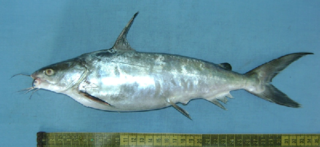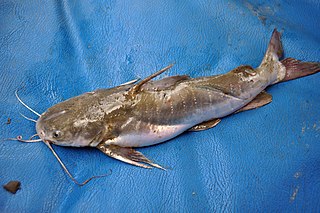
The giant catfish, also known as the giant sea catfish, giant salmon catfish, giant marine-catfish, or the khagga, is a species of catfish in the family Ariidae. It was described by Eduard Rüppell in 1837, originally under the genus Bagrus. It inhabits estuaries and occasionally freshwater bodies, in Japan, Australia, Polynesia, southern Vietnam in the Mekong Delta, the Red Sea and the northwestern Indian Ocean. It dwells at a depth range of 10 to 195 m. It reaches a maximum total length of 185 cm (73 in), but usually reaches a TL of 70 cm (28 in).
The bronze catfish, also known as the giant catfish, the roundsnout sea catfish, or the two-line sea catfish, is a species of catfish in the family Ariidae. It was described by Achille Valenciennes in 1840, originally under the genus Bagrus. It inhabits marine, brackish and freshwaters throughout the Indo-western Pacific. It reaches a maximum standard length of 62 cm (24 in).

Neoarius graeffei, or blue salmon catfish, is a species of catfish found in freshwater rivers of Australia and Papua New Guinea. This species is most identifiable by its large, shark-like dorsal fin that is led by a poisonous spine. Like other catfish, the blue salmon catfish is known to use electrical pulses to sense prey in the water. This prey sensing mechanism may be the reason that these catfish are known to eat the land dwelling hopping mouse at a high rate.

Genidens genidens, the Guri sea catfish or marine catfish, is a species of catfish in the family Ariidae. It was described by Georges Cuvier in 1829, originally under the genus Pimelodus. It is known from southern South American rivers connected to the Atlantic Ocean. It is known to reach a total length of 42.5 cm (16.7 in), but more commonly reaches a TL of 35 cm (14 in). It has been recorded spawning between Autumn and Spring. Its diet includes polychaete worms, plants, finfish, mollusks, and benthic crustaceans.

The Sona sea catfish, also called the marine catfish or the dusky catfish, is a species of catfish in the family Ariidae. It was described by Francis Buchanan-Hamilton in 1822, originally under the genus Pimelodus. It inhabits rivers, estuaries and marine coasts around Pakistan, Indonesia, Polynesia and Thailand. It reaches a maximum total length of 92 cm (36 in), but more commonly reaches a TL of 55 cm (22 in). Its maximum known life expectancy is 6 years. Males and females mate for life.

Hexanematichthys sagor, the Sagor catfish, Sagor sea catfish, Sunda sea-catfish, marine catfish or dusky catfish, is a species of catfish in the family Ariidae. It was described by Francis Buchanan-Hamilton in 1822, originally under the genus Pimelodus. It inhabits estuaries and freshwater bodies in numerous areas of the Indo-Western Pacific ocean. It reaches a maximum total length of 45 cm (18 in), more commonly reaching a TL of 30 cm (12 in).

Nemapteryx caelata, the engraved catfish or engraved sea catfish, is a species of catfish in the family Ariidae. It was described by Achille Valenciennes in 1840, originally under the genus Arius. It inhabits marine and brackish waters in Bangladesh, India, Myanmar, Pakistan, Sri Lanka, and Thailand. It reaches a maximum total length of 45 cm (18 in), more commonly reaching a TL of 24 cm (9.4 in).
Neoarius leptaspis, the salmon catfish, boofhead catfish, freshwater forked tailed catfish, lesser salmon catfish, or triangular shield catfish, is a species of catfish in the family Ariidae. It was described by Pieter Bleeker in 1862, originally under the genus Hexanematichthys. It inhabits marine, brackish and freshwaters in Australia and New Guinea, at a maximum known depth of 135 m (443 ft). It reaches a maximum standard length of 60 cm (24 in).
Neoarius latirostris, the broad-snouted catfish, is a species of catfish in the family Ariidae. It was described by William John Macleay in 1883, originally under the genus Arius. It inhabits freshwater rivers in Indonesia and Papua New Guinea. Its diet includes finfish, mollusks, prawns, terrestrial arthropods, aquatic insects, and plants. It reaches a maximum standard length of 50 cm (20 in).
Neoarius pectoralis, the sawspine catfish or sawspined catfish, is a species of catfish in the family Ariidae. It was described by Patricia J. Kailola in 2000, originally under the genus Arius. It inhabits marine and brackish waters in Australia, Irian Jaya, and possibly also Papua New Guinea. It reaches a maximum fork length of 39.3 cm (15.5 in).
Neoarius utarus, the northern rivers catfish or salmon catfish, is a species of catfish in the family Ariidae. It was described by Patricia J. Kailola in 1990, originally under the genus Arius. It inhabits freshwater bodies in Indonesia and Papua New Guinea.
Neoarius velutinus, the papillate catfish, is a species of catfish in the family Ariidae. It was described by Max Carl Wilhelm Weber in 1907, originally under the genus Hemipimelodus. It inhabits freshwater lakes and rivers in New Guinea. Its diet includes mayflies and other terrestrial and aquatic insects, detritus, benthic algae, and crustaceans.
The sculptured sea catfish is a species of catfish in the family Ariidae. It was described by Franz Steindachner in 1876, originally under the genus Arius. It inhabits brackish and marine waters in Costa Rica, Mexico and Panama. It reaches a maximum total length of 45 cm (18 in), more commonly reaching a TL of 40 cm (16 in).
The Chili sea catfish is a species of catfish in the family Ariidae. It was described by Theodore Gill in 1863, originally under the genus Sciades. It inhabits marine and brackish waters in Mexico, Costa Rica, Honduras, Ecuador, El Salvador, Colombia, Peru, Nicaragua, Guatemala, and Panama. It dwells at a depth range of 10 to 30 m. It reaches a maximum total length of 70.6 cm (27.8 in), more commonly reaching a TL of 30 cm (12 in).
The longsnouted catfish, also known as the Broadbent's catfish, the spoon-nosed catfish, the large-scaled catfish, the sharp-headed catfish, or the sand catfish, is a species of catfish in the family Ariidae. It was described by Achille Valenciennes in 1840, originally under the genus Arius. It inhabits brackish and marine waters in New Guinea, Australia, and southern and southeastern Asia. It reaches a maximum total length of 50 cm (20 in).

The blacktip sea catfish, also known as the Dussumier's catfish, the giant marine cat fish, the Shupanga sea catfish, or the tropical seacatfish, is a species of catfish in the family Ariidae. It was described by Achille Valenciennes in 1840, originally under the genus Arius. It inhabits rivers and marine waters ranging between Africa and India in the Indo-western Pacific. It dwells at a depth range of 20 to 50 m. It reaches a maximum standard length of 62 cm (24 in), and a maximum weight of 1.4 kg (3.1 lb).
The thinspine sea catfish, also known as the Day's catfish, is a species of catfish in the family Ariidae. It was described by Francis Day in 1866, originally under the genus Arius. It inhabits brackish and coastal marine waters in Mozambique, Sri Lanka, and the Persian Gulf. It dwells at a depth range of 20 to 50 m. It reaches a maximum total length of 36 cm (14 in), more commonly reaching a TL of 23 cm (9.1 in).

The Pemecou sea catfish, also known as the flapnose sea catfish, the mud cuirass, or the gillbacker, is a species of catfish in the family Ariidae. It was described by Marcus Elieser Bloch in 1794, originally under the genus Silurus. It inhabits marine, brackish and freshwaters in Brazil, Guyana, French Guiana, Colombia, Suriname, Venezuela, and Trinidad and Tobago. It dwells at a depth range of 1 to 5 m. It reaches a maximum total length of 94.2 cm (37.1 in), while males more commonly reach a TL of 30 cm (12 in) and females reach a TL of 62.5 cm (24.6 in). It reaches a maximum weight of 1.5 kg (3.3 lb).
Sciades paucus is a species of catfish in the family Ariidae. It was described by Patricia J. Kailola in 2000, originally under the genus Arius. It inhabits freshwaters in Australia. It reaches a maximum total length of 130 cm (51 in), and a maximum weight of 2.8 kg (6.2 lb).
The crucifix sea catfish — also known as the Christfish, the crucifix/crucifex catfish, the crucifixfish, or the gillbacker, — is a species of catfish in the family Ariidae.







